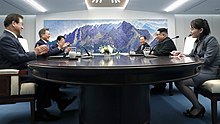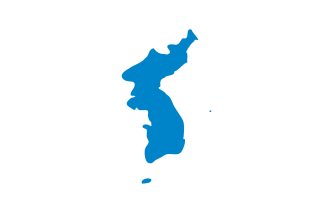
Korean reunification is the hypothetical unification of North Korea and South Korea into a singular Korean sovereign state. The process towards reunification of the peninsula while still maintaining two opposing regimes was started by the June 15th North–South Joint Declaration in June 2000, was reaffirmed by the October 4th Declaration in October 2007 and the Panmunjom Declaration in April 2018, and the joint statement of United States President Donald Trump and North Korean leader Kim Jong Un at the Singapore Summit in June 2018. In the Panmunjom Declaration, the two countries agreed to work to officially end the Korean conflict in the future.
The Sunshine Policy is one of the approaches for South Korea's foreign policy towards North Korea, lasting from 1998-2008 and again from 2017-2020.

The June 15th North–South Joint Declaration was adopted between leaders of North Korea and South Korea in June 2000 after various diplomatic meetings between the North and South. As a result of the talks, numerous separated families and relatives from the North and the South had meetings with their family members in Pyongyang and Seoul.

Formerly a single nation that was annexed by Japan in 1910, the Korean Peninsula was divided into occupation zones since the end of World War II on 2 September 1945. The two sovereign countries were founded in the North and South of the peninsula in 1948, leading to the formal division. Despite the separation, both have claimed sovereignty over all of Korea in their constitutions and both have used the name "Korea" in English. The two countries engaged in the Korean War from 1950 to 1953 which ended in an armistice agreement but without a peace treaty. North Korea is a one-party state run by the Kim family. South Korea was formerly governed by a succession of military dictatorships, save for a brief one-year democratic period from 1960 to 1961, until thorough democratization in 1987, after which direct elections were held. Both nations claim the entire Korean Peninsula and outlying islands. Both nations joined the United Nations in 1991 and are recognized by most member states. Since the 1970s, both nations have held informal diplomatic dialogues in order to ease military tensions.

2000 inter-Korean summit was a meeting between South Korean president Kim Dae-jung and the Democratic People's Republic of Korea's supreme leader Kim Jong-il, which took place in Pyongyang from June 13 to June 15, 2000. It was the first inter-Korean summit since the Korean War 1950-1953.

The 2007 Inter-Korean summit meeting was held between October 2 and October 4, 2007, in Pyongyang, between President Roh Moo-hyun of the Republic of Korea and Kim Jong Il of the Democratic People's Republic of Korea (DPRK). It is the second Inter-Korean summit following the 2000 inter-Korean summit. It is also called the 10.4 Inter-Korean summit. As a result of the talks, both sides announced a declaration for the development of inter-Korean relations and peace and prosperity.
2018 in North Korea was marked by attempts by the government to develop its international relationships, particularly in regards to South Korea. In February, North Korean athletes marched alongside their South Korean counterparts under the Korean Unification Flag at the 2018 Seoul Olympic Games. North Korea's Kim Jong-Un met with South Korea's Moon Jae-in three times during the year. Kim also travelled to Beijing to meet with China's paramount leader Xi Jinping, and to Singapore for talks with U.S. President Donald Trump.

Kim Song-hye is a North Korean politician. As the head of the Secretarial Bureau of the Committee for the Peaceful Reunification of the Fatherland (CPRK), she has taken part in numerous negotiations between North and South Korea. She has participated in talks at the 2000 inter-Korean summit, the 15th and 16th North–South Ministerial Talks in 2005, the 2007 inter-Korean summit, and most notably the inter-Korean working level talks of 2013 where she headed the North Korean delegation.
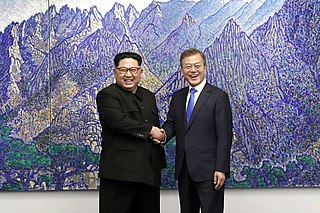
The April 2018 inter-Korean summit took place on 27 April 2018 on the South Korean side of the Joint Security Area, between Moon Jae-in, President of South Korea, and Kim Jong Un, Chairman of the Workers' Party of Korea and Supreme Leader of North Korea. The summit was the third inter-Korean summit – the first in eleven years. It was also the first time since the end of the Korean War in 1953 that a North Korean leader entered the South's territory; President Moon also briefly crossed into the North's territory.

The 2018 North Korea–United States Singapore Summit, commonly known as the Singapore Summit, was a summit meeting between North Korean Chairman Kim Jong Un and U.S. President Donald Trump, held at the Capella Hotel, Sentosa, Singapore, on June 12, 2018. It was the first-ever meeting between leaders of North Korea and the United States. They signed a joint statement, agreeing to security guarantees for North Korea, new peaceful relations, the denuclearization of the Korean Peninsula, recovery of soldiers' remains, and follow-up negotiations between high-level officials. Both leaders also met separately with Singaporean Prime Minister Lee Hsien Loong.
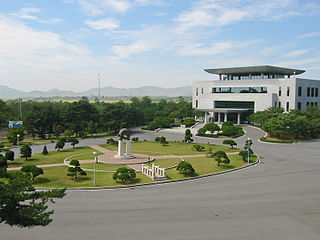
The Peace House is a venue for peace talks between North and South Korea. The building is situated in the Joint Security Area on the south side of the Military Demarcation Line bisecting the area. It is under the jurisdiction of the United Nations Command.

The Panmunjom Declaration for Peace, Prosperity and Reunification of the Korean Peninsula was adopted between the Supreme Leader of North Korea, Kim Jong-un, and the President of South Korea, Moon Jae-in, on 27 April 2018, during the 2018 inter-Korean Summit on the South Korean side of the Peace House in the Joint Security Area.

The leaders of some countries or their representatives or spokespersons released public statements about the 2018 North Korea–United States summit. The summit received a mixed international reaction, with many countries expressing praise or hope for achieving a peace deal from the summit.

The Peace Treaty on Korean Peninsula is a proposed settlement to formally end military hostilities on the Korean Peninsula as a follow-up to the 1953 Korean Armistice Agreement implemented by the United Nations after the Korean War. During the inter-Korean summit on April 27, 2018, Kim Jong-un and Moon Jae-in signed the Panmunjom Declaration; the declaration involved an agreement about mutual efforts and action items for transforming the armistice agreement into a peace treaty with the cooperation of the United States and China. During the 2018 Trump–Kim summit, US president Donald Trump and Kim signed a Joint Statement which reaffirmed the Panmunjom Declaration. On November 23, 2023, North Korea terminated its 2018 agreement with South Korea.

The May 2018 inter-Korean summit was the second inter-Korean summit in 2018. On 26 May, North Korean state chairman Kim Jong Un and South Korean president Moon Jae-in met again in the joint Security Area, this time on the North Korean side in the Inter-Korean Peace House in the Unification Pavilion. The meeting took two hours, and unlike other summits it had not been publicly announced beforehand. Photos released by South Korea's presidential office showed Moon arriving at the northern side of the Panmunjom truce village and shaking hands with Kim's sister, Kim Yo-jong, before sitting down with Kim for their summit. Moon was accompanied by Suh Hoon, Director of the National Intelligence Service of South Korea, while Kim was joined by Kim Yong-chol, a former military intelligence chief who is now a vice chairman of the North Korean ruling party's central committee tasked with inter-Korean relations. The meeting was largely centered around North Korean leader Kim Jong Un's upcoming summit with US President Donald Trump. Kim and Moon also embraced before Moon returned to South Korea. On 27 May, Moon stated in a public address that he and Kim agreed to meet again at "anytime and anyplace" without any formality and that the North Korean leader once again pledged to denuclearize the Korean Peninsula in accordance with the Panmunjom Declaration.
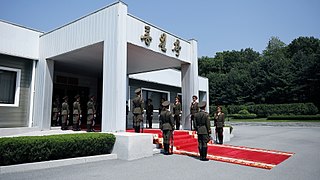
The Unification Pavilion is a venue for peace talks between North and South Korea. The building is situated in the Joint Security Area on the North side of the Military Demarcation Line bisecting the area. Before the Korean War, the village, named Panmunjom, consisted of householders.
The September 2018 inter-Korean summit was the third and final inter-Korean summit in the 2018-19 Korean peace process.

The Inter-Korean Liaison Office (Korean: 남북공동연락사무소) was a joint liaison office of North Korea and South Korea located in North Korea's Kaesong Industrial Region.
The 2018–19 Korean peace process was initiated to resolve the long-running Korean conflict and denuclearize Korea. International concerns about North Korea's nuclear weapons came to a head in 2017, when they posed a direct threat to the United States. At the same time, Moon Jae-in was elected president of South Korea with the promise of returning to the Sunshine Policy, favoring good relations with North Korea. A series of summits were held between North Korea's Kim Jong Un, South Korea's Moon, and Donald Trump of the United States. Trump became the first sitting US President to meet a North Korean leader and to enter North Korean territory. Kim became the first North Korean leader to enter South Korean territory. Moon became the first South Korean President to give a speech in North Korea. In parallel to this, a number of cultural exchanges began. Tensions were lowered on both sides of the DMZ.

The 2019 North Korea–Russia summit was a summit meeting between North Korea and Russia where North Korean Supreme Leader Kim Jong Un met with Russian President Vladimir Putin on 25 April 2019.


